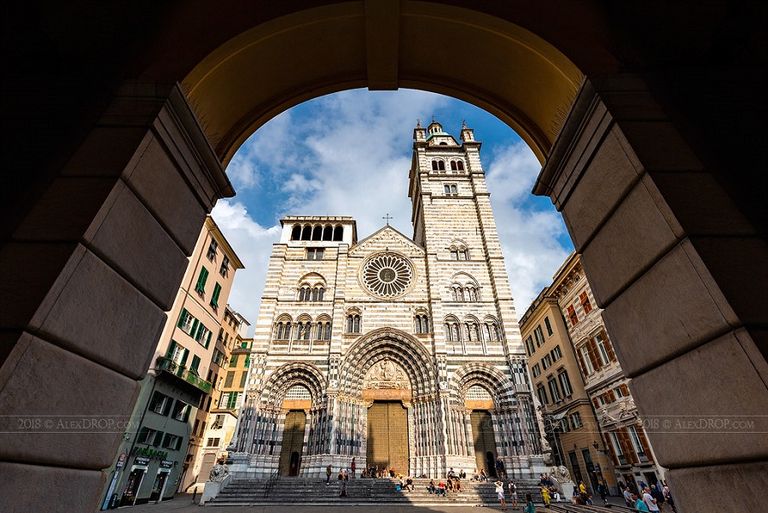
I continue to show you some things about Genoa, the Ligurian capital that marked my life for 20 years of living there before returning to my country of origin.
Today I am going to refer to the Cathedral of San Lorenzo which, among its somewhat peculiar characteristics, preserves an intact bomb inside, which fell during a bombing in World War II and remained unexploded. A testimony to the madness of humanity and some rulers blinded by power and pride.
When we talk about the hand of God we are perhaps referring to events like this.
The majestic Cathedral of San Lorenzo is the historical, artistic and religious heart of the city of Genoa and is therefore one of the most beloved symbols of the Superba.
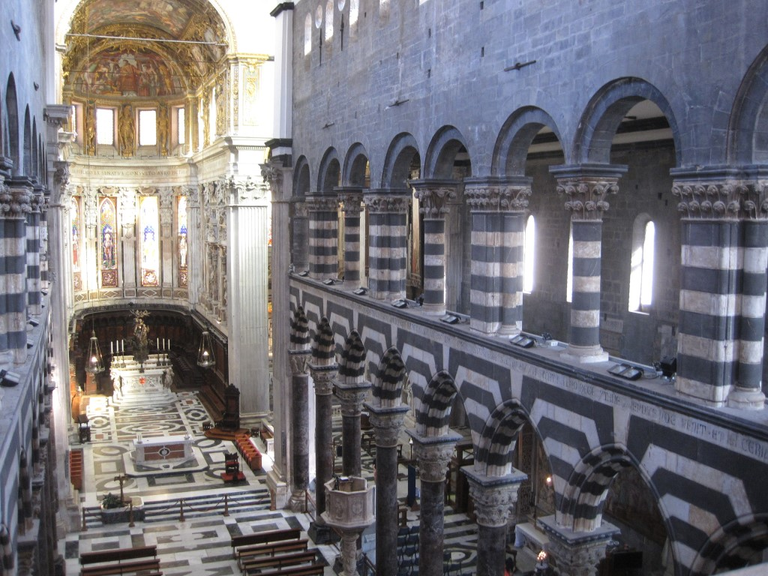
The façade features splendid Gothic portals, unique in Italy, for which French craftsmen were called in the third decade of the 13th century.
During the Second World War, Genoa suffered many bombings and in 1941, during a bombardment by the English fleet, a shell pierced the roof of the Cathedral but miraculously remained unexploded.
It is impossible not to be enchanted by the majesty of its black and white striped façade, the bell tower that dominates the historic centre, the meticulous details that contribute to making the building a true architectural jewel. It is the cathedral of San Lorenzo, the most important church in Genoa.
Built around 1098 on a previous basilica from the 5th-6th century and enlarged over the centuries with solemn and precious forms, the cathedral dedicated to San Lorenzo Martyr houses the ashes of the city's patron saint, San Giovanni Battista, who arrived in Genoa at the end of the First Crusade.
Legend.
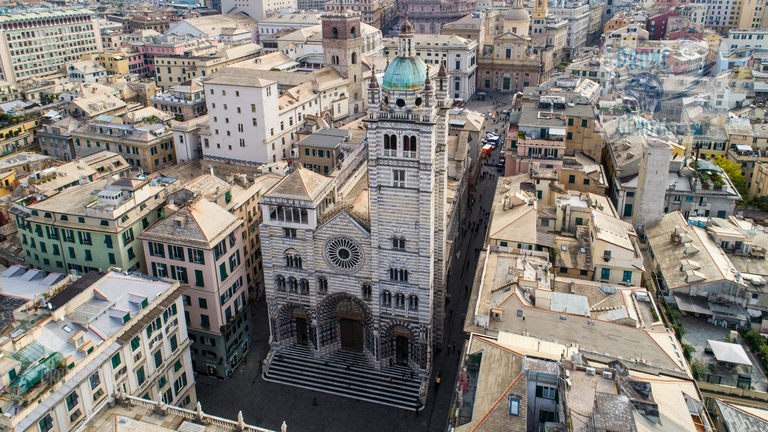
Curious stories and fascinating legends surround the Genoese cathedral and the representations on its façade.
We will reveal one of them to you right away: as an eternal reminder of the horrors of war, inside the cathedral, in the right nave, there is an exact copy of an unexploded ordnance.
The grenade was fired in 1941 by the British fleet during one of the worst attacks on Genoa during the Second World War.
History.
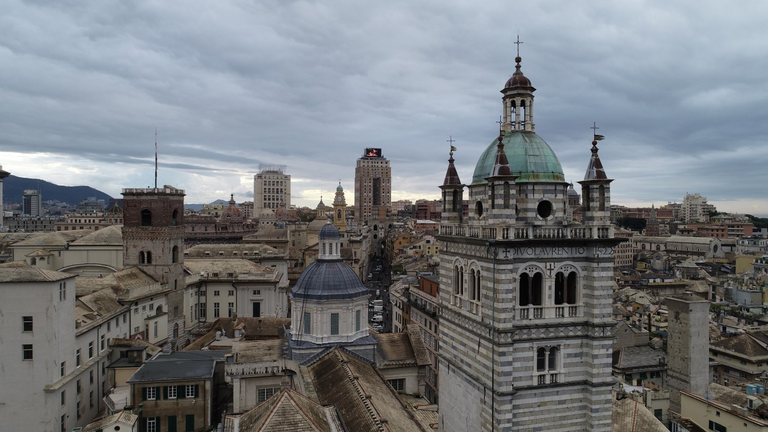
The Basilica of San Lorenzo became a cathedral from the 9th century onwards, replacing the Basilica of the Twelve Apostles, dedicated in the 6th century to San Siro, bishop of Genoa, which at that time was located outside the old town centre.
Thanks to the relocation of the cathedral and the construction of the walls, the area of San Lorenzo became the heart of the city, which grew and changed: in a city without squares, the cemetery of San Lorenzo offered a fundamental stage for political and civil life throughout the Middle Ages.
Pope Gelasius I consecrated it as a cathedral in 1118 and began its reconstruction in the form of a Romanesque church, with funds from municipal taxes and military enterprises such as the Crusades. From 1133 the church obtained the rank of archiepiscopal church.
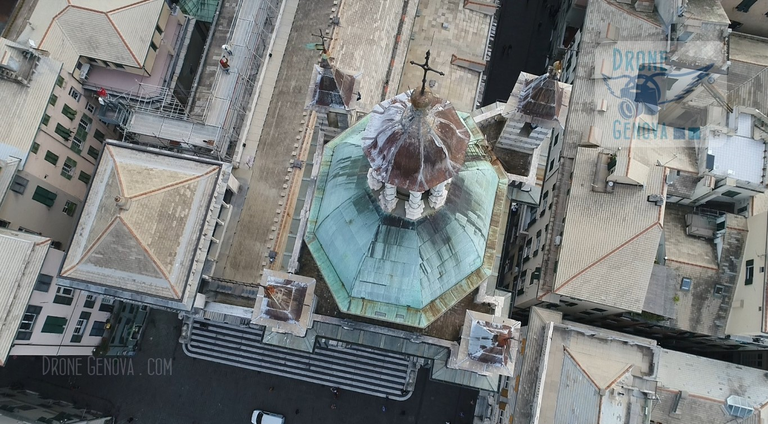
After the fire of 1296, the building was partially restored and partially rebuilt in the forms of Gothic architecture: between 1307 and 1312 the majestic façade with black and white bands was completed, the counter-façade was frescoed and the internal colonnades were remade, with new capitals and the addition of false matronaeums; As is often the case in Genoa, the Romanesque structures are well preserved.
Between the 14th and 15th centuries, the cathedral was enriched with new altars and chapels, including the splendid chapel that houses the ashes of St. John the Baptist, a true masterpiece of 15th-century art, in the left nave.
In 1455, the small loggia was built in the north-east tower on the façade, to which the opposite one was added in 1522, with the typical forms of Mannerist architecture.
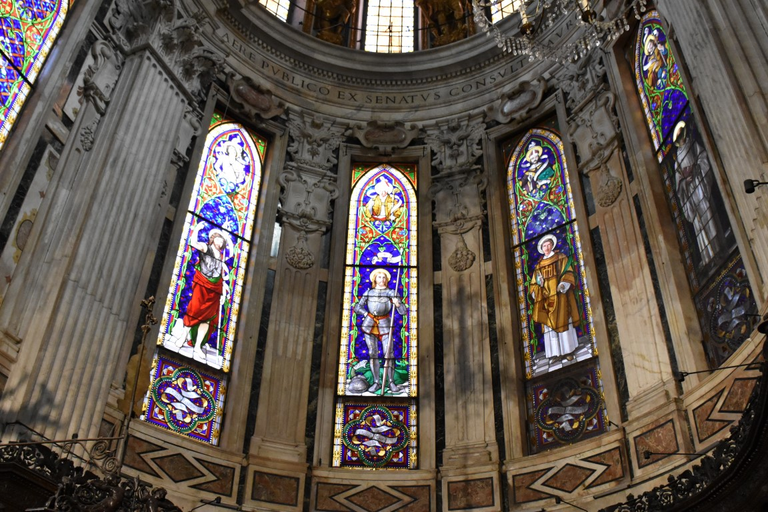
In the mid-16th century, by order of the city magistrates, the Perugian architect Galeazzo Alessi redesigned the entire building, managing to reconstruct only the roof of the naves, the floor, the dome and the apse area. But the cathedral was finally completed in the 17th century, with the triumph of gilded stucco in the apse and the late Mannerist frescoes of the “Stories of San Lorenzo” by Lazzaro Tavarone.
A restoration at the end of the 19th century enhanced the medieval parts that characterise the cathedral's current appearance.
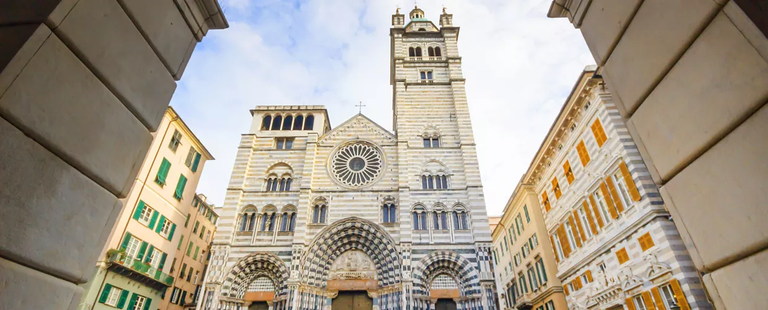
Continúo mostrándoles algunas cosas de Genova, la capital ligure que marcó mi vida durante 20 años de vivir en ella antes de regresar a mi país de origen.
Hoy me voy a referiri a la Catedral de San Lorenzo que, entre sus características, un poco particulares, conserva una bomba intacta en su interior, que cayó durante un bombardeo en la Segunda Guerra Mundial y quedó sin explotar. Un testimonio de la locura de la humanidad y de algunos gobernantes ciegos de poder y soberbia.
Cuando hablamos de la mano de Dios tal vez nos referimos a hechos como éste.
La majestuosa Catedral de San Lorenzo es el corazón histórico, artístico y religioso de la ciudad de Génova y es por tanto uno de los símbolos más queridos de la Superba.
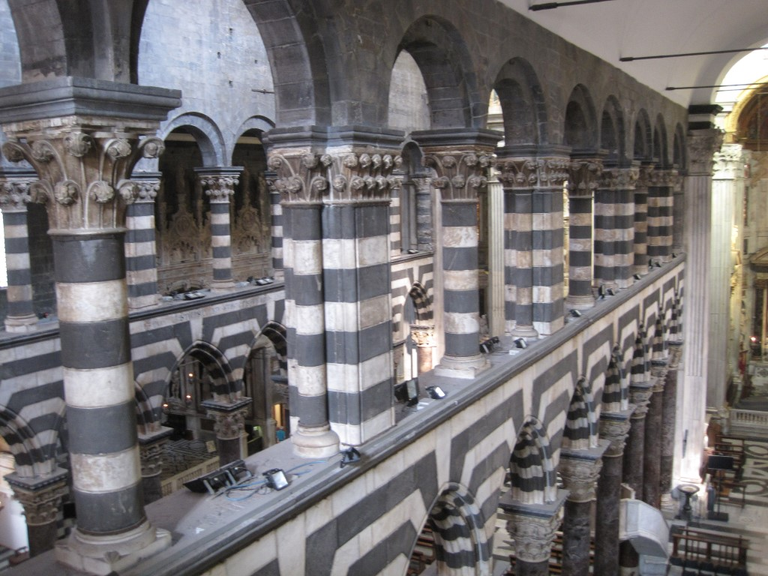
La fachada presenta espléndidos portales góticos, únicos en Italia, para los que se llamaron artesanos franceses en la tercera década del siglo XIII.
Durante la Segunda Guerra Mundial, Génova sufrió muchos bombardeos y en 1941, durante un bombardeo de la flota inglesa, un proyectil atravesó el techo de la Catedral pero milagrosamente permaneció sin explotar.
Es imposible no quedar encantado ante la majestuosidad de su fachada de rayas blancas y negras, el campanario que domina el centro histórico, los minuciosos detalles que contribuyen a hacer del edificio una auténtica joya arquitectónica. Es la catedral de San Lorenzo, la iglesia más importante de Génova.
Construida alrededor del año 1098 sobre una basílica precedente del siglo V-VI y ampliada a lo largo de los siglos con formas solemnes y preciosas, la catedral dedicada a San Lorenzo Mártir alberga las cenizas del santo patrón de la ciudad, San Giovanni Battista , llegados a Génova al final de la Primera Cruzada.
Leyenda.
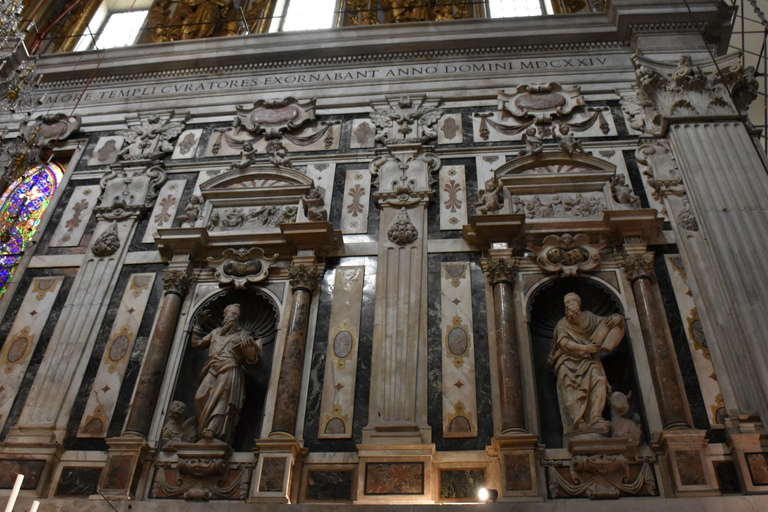
Historias curiosas y leyendas fascinantes circulan en torno a la catedral genovesa y las representaciones de su fachada. Os desvelamos uno enseguida: como recuerdo eterno de los horrores de la guerra, en el interior de la catedral, en la nave derecha, hay una copia exacta de un artefacto sin explotar . La granada fue disparada en 1941 por la flota británica durante uno de los peores ataques contra Génova durante la Segunda Guerra Mundial.
Historia.
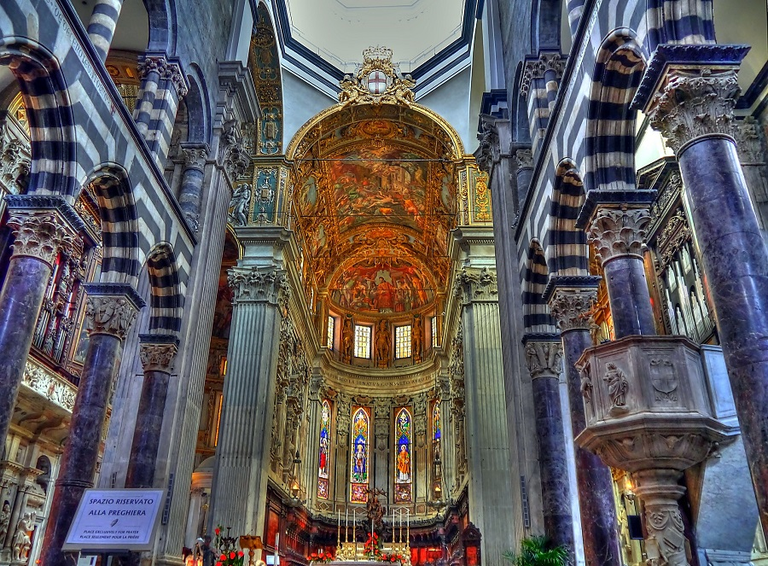
La Basílica de San Lorenzo se convirtió en catedral a partir del siglo IX, sustituyendo a la Basílica de los Doce Apóstoles, dedicada en el siglo VI a San Siro, obispo de Génova, que en ese momento se encontraba fuera del núcleo antiguo de la ciudad.
Gracias al traslado de la catedral y a la construcción de las murallas, la zona de San Lorenzo se convirtió en el corazón de la ciudad que creció y cambió: en una ciudad sin plazas, el cementerio de San Lorenzo ofreció un escenario fundamental para la vida política y civil a lo largo de la Edad Media.
El papa Gelasio I la consagró como catedral en 1118 e inició su reconstrucción en forma de iglesia románica , con fondos procedentes de impuestos municipales y de empresas militares como las Cruzadas. Desde 1133 la iglesia obtuvo el rango de arzobispal.
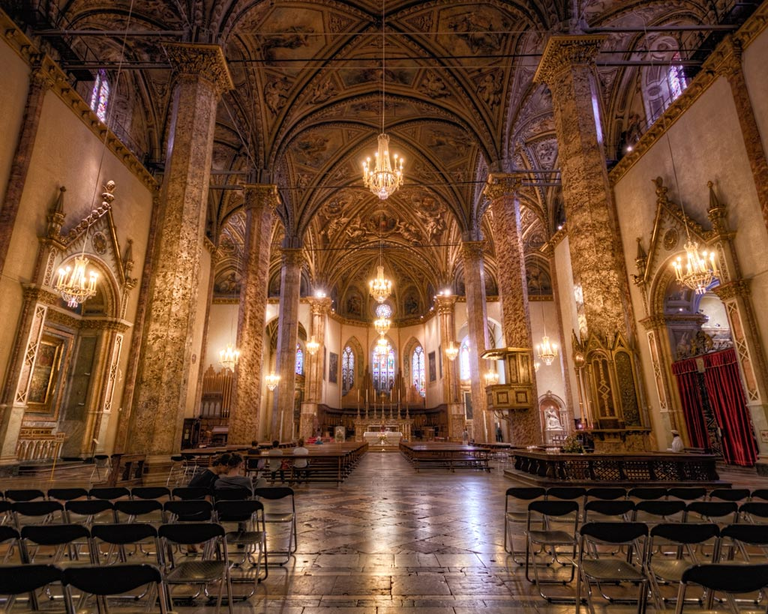
Después del incendio de 1296, el edificio fue parcialmente restaurado y parcialmente reconstruido según las formas de la arquitectura gótica : entre 1307 y 1312 se completó la majestuosa fachada con bandas blancas y negras, se pintó al fresco la contrafachada y se rehicieron las columnatas internas, con nuevos capiteles y la adición de falsos matroneos; Como suele ocurrir en Génova, las estructuras románicas se conservan en buen estado.
Entre los siglos XIV y XV la catedral se enriqueció con nuevos altares y capillas, entre ellas la espléndida capilla que conserva las cenizas de San Juan Bautista, verdadera obra maestra del arte del siglo XV, en la nave izquierda.
En 1455 se construyó la pequeña logia en la torre noreste, en la fachada, a la que se añadió la opuesta en 1522, con las formas típicas de la arquitectura manierista.
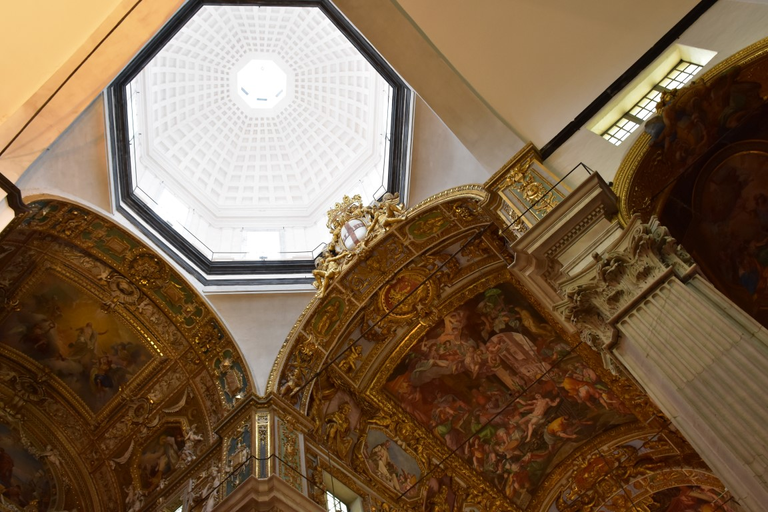
A mediados del siglo XVI, por orden de los magistrados de la ciudad, el arquitecto perusino Galeazzo Alessi rediseñó todo el edificio, logrando reconstruir sólo la cubierta de las naves, el suelo, la cúpula y la zona del ábside. Pero para ver finalmente la finalización de la catedral hubo que esperar hasta el siglo XVII, con el triunfo del estuco dorado en el ábside y los frescos manieristas tardíos de las “Historias de San Lorenzo” de Lazzaro Tavarone .
Una restauración de finales del siglo XIX realzó las partes medievales que caracterizan el aspecto actual de la catedral.
Source images / Fuente imágenes.


